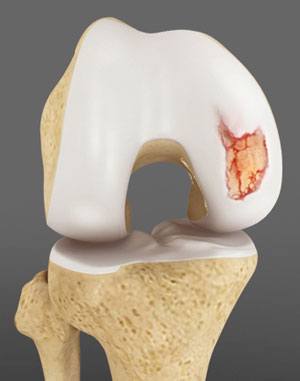
Articular or hyaline cartilage is the tissue that covers the surfaces of the two bones in the knee joint. This cartilage allows the bones to move smoothly against each other and can support the body's weight during activities like running and jumping. Unlike other tissues, articular cartilage does not receive a direct blood supply, which means it has a limited ability to repair itself. When this cartilage is torn, it does not heal well, and this can result in the deterioration of the joint surface, eventually leading to the development of osteoarthritis.
Articular cartilage damage can occur in individuals of any age. It may result from traumatic events like accidents, mechanical injuries such as falls, or from degenerative joint conditions like osteoarthritis, which typically develop in older adults.
Patients with articular cartilage damage experience symptoms such as joint pain, swelling, stiffness, and a decrease in range of motion of the knee. Damaged cartilage needs to be replaced with healthy cartilage and the procedure is known as cartilage replacement. It is a surgical procedure performed to replace the worn out cartilage and is usually performed to treat patients with small areas of cartilage damage usually caused by sports or traumatic injuries. It is not indicated for those patients who have advanced arthritis of knee.
Cartilage replacement helps relieve pain, restore normal function, and can delay or prevent the onset of arthritis. The goal of cartilage replacement procedures is to stimulate growth of new hyaline cartilage.
Various arthroscopic procedures involved in cartilage replacement include:
- Microfracture
- Drilling
- Abrasion Arthroplasty
- Autologous chondrocyte implantation (ACI)
- Osteochondral Autograft Transplantation
- Microfracture: In this method numerous holes are created in the injured joint surface using a sharp tool. This procedure stimulates healing response by creating new blood supply. Blood supply results in growth of new cartilage.
- Drilling: In this method a drilling instrument is used to create holes in the injured joint surface. Drilling holes creates blood supply and stimulate growth of new cartilage. Although the method is similar to microfracture, it is less precise and the heat produced during drilling may damage other tissues.
- Abrasion Arthroplasty: High speed metal-like object is used to remove the damaged cartilage. This procedure is performed using an arthroscope.
- Osteochondral Autograft Transplantation: Healthy cartilage tissue (graft) is taken from the bone that bears less weight and is transferred to the injured joint place. This method is used for smaller cartilage defects.
- Osteochondral Allograft Transplantation: A cartilage tissue (graft) is taken from a donor and transplanted to the site of the injury. Allograft technique is recommended if larger part of cartilage is damaged.
- Autologous Chondrocyte implantation: In this method a piece of healthy cartilage from other site is removed using arthroscopic technique and is cultured in laboratory. Cultured cells form a larger patch which is then implanted in the damaged part by open surgery.
Following the surgery, rehabilitation procedures are advised to necessitate healing and to restore normal functioning of the joint.
Other Special Interest – Knee
-

Meniscus Transplant
-

ACL / PCL / MCL
-

Total Knee Replacement
-

Articular Cartilage Repair
-

Meniscus Surgery
